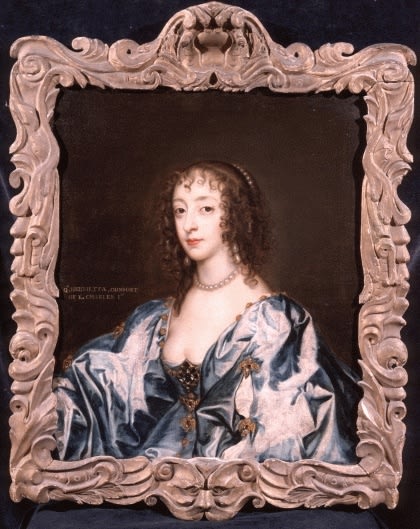
Circle of Sir Anthony van Dyck
To view all current artworks for sale visit philipmould.com
This elegant portrait of Henrietta Maria (1609-1669) is a good contemporary head and shoulders version of one of van Dyck's most beautiful images of the Queen. The full three-quarter length composition of c.1638 survives in two autograph versions, one in the Wallace Collection -to which, in treatment of the face, our picture is closest- and a second in the San Diego Museum of Art, California.
The painting very clearly demonstrates van Dyck's much-admired conception of female portraiture, and the Queen appears beautiful but modest, reserved and yet engagingly confident, whilst the mastery of the blue silk dress imparts a Baroque opulence to the whole. Familiar with such images, Prince Rupert's youngest sister, Sophia was surprised -and perhaps delighted- to find the Queen to be a small, badly postured woman with ''teeth protruding from her mouth like guns from a fort''. It is to be noted, though, that Van Dyck's interpretation of the Queen's features accords with earlier likenesses by Daniel Mytens and Hendrick Pot, and that seventeenth century observers tend to extremes in descriptions of appearance.
Born in 1609 as the youngest daughter of Henri IV of France and Marie de Medici, Henrietta Maria was proposed as a suitable candidate for a match with the future Charles I from an early age. Married by proxy in May 1625, Henrietta landed in England the following month and began her life as Queen of England at the age of sixteen.
As a devout French Catholic in a Protestant English court, the Queen's first years in England were not happy ones. Her religious convictions and the Duke of Buckingham's attempts to turn Charles against her provoked antagonisms which were resolved only after the Duke's murder in 1628. The birth of Charles Prince of Wales followed soon after in May 1630. She subsequently became the mother of Princess Mary, (1631) mother to King William III, the Duke of York (1633) the future James II, Princess Elizabeth (1635), Princess Anne (1637), Henry, Duke of Gloucester (1640), and Henrietta, Duchess of Orleans (1644).
The Queen's role in her husband's court proved complicated. The combination of her frivolity and her emotional influence over the King caused concern among courtier-politicians such as the Earl of Strafford. Her continuing devotion to her religious beliefs also created conflict. Emissaries from Rome and English Catholics formed a large segment of her court circle and were openly resented by more conservative courtiers and non-conformists.
During the Civil War Henrietta Maria became actively involved in raising funds and troops in support of the King. In arranging mercenary marriages for her children, pawning the crown jewels, attempting landings in munitions ships and flying to her husband's side at the Battle of Edgehill, the events of her life at this war-torn period demonstrate an heroic devotion to her husband and to his cause, and show the strength of her character and her courage at their very best. While fleeing the approach of the Parliamentary Army the Queen stopped to give birth to her youngest child before escaping to the safety of France in July 1644. Living under the protection of the Queen Regent at St. Germain, she was later joined by her children shortly before the execution of her husband. After 1648, Henrietta became solely dependent upon the good will of others for her livelihood. Impoverished and forced to leave France she was not to return again to England until 1660. Amidst failing health and what she considered to be English indifference to her sufferings returned to France in 1665, where she died four years later.
The possession of Royal portraits such as this -and a companion portrait of King Charles I, which Lord Talbot de Malahide also exhibited in 1847 - was a customary mark of Royal favour or of loyalty to the Crown. The family history of the Talbots is as exemplary as any of feudal service to the monarch: under the terms of the charter by which Henry II granted the Castle of Malahide near Dublin to the family they were forbidden ever to acknowledge as superior or to do any service for any authority but the English Crown. This did not, however, make them puppets of the King or of his ministers, and in the 1630s Richard Talbot won a suit against the Earl of Strafford who had laid claim to the Admiralty of the Port of Malahide and other ancient and hereditary privileges. Richard Talbot's son, John, was turned out of his estates during the Commonwealth for his loyalty to the Crown, but he was reinstated at the Restoration.
The 1847 exhibition The Works of the Ancient Masters was organised by the Royal Irish Art Union in aid of relief for the Irish Famine. Within the space of three weeks Stewart Blacker, the Hon. Secretary of the Royal Irish Art Union, and a Committee of Management which included the Lord Talbot de Malahide, organised an exhibition of 228 works from significant collections including those of the Earls of Arran, Milltown and Charlemont. This venture, which might be regarded as an example of fundraising quite ahead of its time, was a great success, providing a total of £500 for the relief of the Irish Famine.
Provenance
Lord Talbot de Malahide, Malahide Castle near Dublin
Exhibitions
The Works of the Ancient Masters, Royal Irish Art Union, Dublin, April-May 1847 (no. 185)